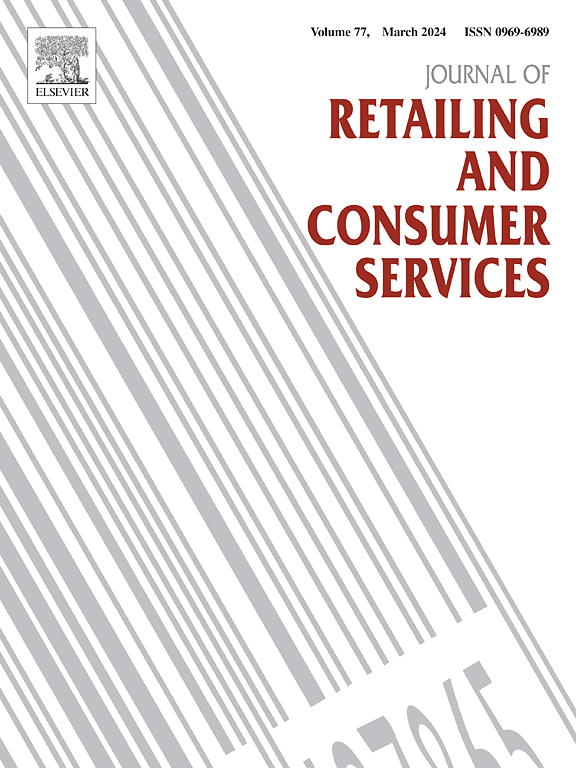Unveiling the influencing mechanism underlying users’ adoption and recommend intentions of central bank digital currency: A behavioral reasoning theory perspective
IF 11
1区 管理学
Q1 BUSINESS
Journal of Retailing and Consumer Services
Pub Date : 2024-08-24
DOI:10.1016/j.jretconser.2024.104050
引用次数: 0
Abstract
Despite the enormous benefits of the implementation of central bank digital currency (CBDC), the realization of these anticipated benefits depends on users' adoption and recommendations resulting from the consideration of both facilitators and inhibitors. Drawing on the behavioral reasoning theory (BRT), this study endeavors to unveil the influencing mechanism underlying users' CBDC adoption and recommend intentions using a hybrid approach integrating qualitative study (i.e., thematic analysis) and quantitative study (i.e., PLS-SEM). The qualitative research results indicate that relative advantage, incentive measures, government support, compatibility, and convenience are the “reasons for” users' CBDC adoption and recommend intentions, while tradition barrier, risk barrier, usage barrier, and image barrier are the “reasons against” users' CBDC adoption and recommend intentions. Further, the quantitative analysis of 638 pilot CBDC users suggests that users' CBDC adoption intentions positively influence their CBDC recommend intentions. “Reasons for” positively influence both users' attitudes and adoption intentions toward CBDC, whereas “reasons against” only negatively influence users' adoption intentions toward CBDC. Values (openness to change) positively influence users' “reasons for” and attitudes toward CBDC, and negatively influence users' “reasons against” adopting CBDC. Financial literacy strengthens the paths between “reasons for” and adoption intentions and weakens the paths between “reasons against” and adoption intentions. Theoretically, this study contributes by providing a thorough knowledge of users’ values, reasons, attitudes, and adoption and recommend intentions toward CBDC. Practically, this study renders insightful policy implications for central banks worldwide to promote CBDC applications.揭示用户采用和推荐央行数字货币意图的影响机制:行为推理理论视角
尽管央行数字货币(CBDC)的实施会带来巨大的利益,但这些预期利益的实现取决于用户的采用和推荐,而用户的采用和推荐则同时考虑了促进因素和抑制因素。本研究借鉴行为推理理论(BRT),采用定性研究(即主题分析)和定量研究(即 PLS-SEM)相结合的混合方法,努力揭示用户采用 CBDC 和推荐意向的影响机制。定性研究结果表明,相对优势、激励措施、政府支持、兼容性和便利性是用户采用和推荐 CBDC 的 "原因",而传统障碍、风险障碍、使用障碍和形象障碍则是用户采用和推荐 CBDC 的 "反对原因"。此外,对 638 名 CBDC 试点用户的定量分析表明,用户的 CBDC 采用意愿会对其 CBDC 推荐意愿产生积极影响。"支持的原因 "对用户采用 CBDC 的态度和意向都有积极影响,而 "反对的原因 "只对用户采用 CBDC 的意向有消极影响。价值观(对变化的开放性)对用户采用 CBDC 的 "原因 "和态度有积极影响,而对用户采用 CBDC 的 "反对原因 "有消极影响。金融知识加强了 "支持原因 "与采用意愿之间的路径,削弱了 "反对原因 "与采用意愿之间的路径。从理论上讲,本研究有助于全面了解用户对 CBDC 的价值观、原因、态度、采用意向和推荐意向。在实践中,本研究为全球中央银行推广 CBDC 应用提供了深刻的政策启示。
本文章由计算机程序翻译,如有差异,请以英文原文为准。
求助全文
约1分钟内获得全文
求助全文
来源期刊
CiteScore
20.40
自引率
14.40%
发文量
340
审稿时长
20 days
期刊介绍:
The Journal of Retailing and Consumer Services is a prominent publication that serves as a platform for international and interdisciplinary research and discussions in the constantly evolving fields of retailing and services studies. With a specific emphasis on consumer behavior and policy and managerial decisions, the journal aims to foster contributions from academics encompassing diverse disciplines. The primary areas covered by the journal are:
Retailing and the sale of goods
The provision of consumer services, including transportation, tourism, and leisure.

 求助内容:
求助内容: 应助结果提醒方式:
应助结果提醒方式:


